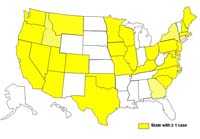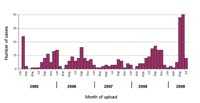Contact CDC
- 800-CDC-INFO
888-232-6348 (TTY)
cdcinfo@cdc.gov - Report a Foodborne Illness
Multistate Outbreak of E. coli O157:H7 Infections Linked to Eating Raw Refrigerated, Prepackaged Cookie Dough
Updated August 7, 2009 (FINAL Web Update)
States Where Persons Infected with the Outbreak Strain of E. coli O157:H7 Live, United States, by State, March 1, 2009 to July 31, 2009

CDC is collaborating with public health officials in many states, the United States Food and Drug Administration (FDA), and the United States Department of Agriculture Food Safety and Inspection Service (FSIS) to investigate an outbreak of E. coli O157:H7 infections.
As of Friday, July 31, 2009, 80 persons infected with a strain of E. coli O157:H7 with a particular DNA fingerprint have been reported from 31 states. Of these, 70 have been confirmed by an advanced DNA test as having the outbreak strain; these confirmatory test results are pending on the others. The number of ill persons identified in each state is as follows: Arizona (2), California (5), Colorado (6), Connecticut (1), Delaware (1), Georgia (2), Iowa (2), Idaho (1), Illinois (7), Kentucky (2), Massachusetts (4), Maryland (2), Maine (3), Minnesota (8), Missouri (1), Montana (1), North Carolina (2), New Hampshire (2), New Jersey (1), Nevada (2), New York (1), Ohio (3), Oklahoma (1), Oregon (1), Pennsylvania (2), South Carolina (1), Texas (3), Utah (4), Virginia (2), Washington (6), and Wisconsin (1).
Most persons became ill during May and June. Ill persons range in age from 2 to 65 years; however, 66% are less than 19 years old; 69% are female. Thirty-five persons have been hospitalized, 10 developed hemolytic uremic syndrome (HUS); none have died.
Investigation of the Outbreak
In an epidemiologic study, ill persons answered questions about foods consumed during the days before becoming ill and investigators compared their responses to those of persons of similar age and gender previously reported to State Health Departments with other illnesses. Preliminary results of this investigation indicate a strong association with eating raw prepackaged cookie dough. Most patients reported eating refrigerated prepackaged Nestle Toll House cookie dough products raw.
On June 29, 2009, the U.S. Food and Drug Administration announced that a culture of a sample of prepackaged Nestle Toll House refrigerated cookie dough currently under recall yielded E. coli O157:H7. The contaminated sample was collected at the firm on June 25, 2009. Further laboratory testing showed that the strain in the sample was not the outbreak strain.
E. coli O157:H7 has not been previously associated with eating raw cookie dough. CDC, the state health departments, and federal regulatory partners are working together in this ongoing investigation.
Clinical Features
Most people infected with E. coli O157:H7 develop diarrhea (often bloody) and abdominal cramps 2-8 days (average of 3-4 days) after swallowing the organism, but some illnesses last longer and are more severe. Infection is usually diagnosed by culture of a stool sample. Most people recover within a week, but some develop a severe infection. A type of kidney failure called hemolytic uremic syndrome (HUS) can begin as the diarrhea is improving; this can occur in people of any age but is most common in children under 5 years old and the elderly.
Advice to Consumers
The Food and Drug Administration and the Centers for Disease Control and Prevention continue to warn consumers not to eat any varieties of the recalled Nestle Toll House refrigerated cookie dough due to the risk of contamination with E. coli O157:H7. This includes Nestlé Toll House cookie dough that does not say "new batch" on the labeling. Consumers who have the recalled prepackaged, refrigerated Nestle Toll House cookie dough products in their homes should throw it away. Cooking the dough is not recommended because consumers might get the bacteria on their hands or on surfaces. The recall does not include Nestle Toll House morsels, which are used as an ingredient in many home-made baked goods and other baked cookie products. The recall also does not include newly made Nestle refrigerated cookie dough products; these products can be identified by labels with shields that say “new batch” on them.
Individuals who have recently eaten recalled prepackaged, refrigerated Toll House cookie dough and have experienced any of these symptoms should contact their doctor or health care provider immediately. Any such illnesses should be reported to state or local public health authorities.
Consumers should be reminded they should not eat raw food products that are intended for cooking or baking before consumption. Consumers should use safe food-handling practices when preparing such products, including following package directions for cooking at proper temperatures; washing hands, surfaces, and utensils after contact with these types of products; avoiding cross contamination; and refrigerating products properly.
Advice to Retailers, Restaurateurs, and Food-service Operators
Retailers, restaurateurs, and personnel at other food-service operations should not sell or serve any Nestle Toll House prepackaged, refrigerated cookie dough products subject to the recall.
For More Information
- FDA press release*
- FDA Confirms E. Coli O157:H7 in Prepackaged Nestlé Toll House Refrigerated Cookie Dough*
- Update on Recalled Nestlé Toll House Cookie Dough* (July 15, 2009)
- For more information on safe food handling practices, go to FDA - Eating Outdoors, Handling Food Safety: Food Facts*.
- Consumers who have additional questions about these products should contact Nestle consumer services at 1-800-559-5025 and/or visit their website at Nestlé Very Best Baking*.
- For a complete listing of the recalled products go to: Nestlé USA's Baking Division Initiates Voluntary Recall*
- For more information about E. coli O157:H7
Previous Updates
* Links to non-Federal organizations found at this site are provided solely as a service to our users. These links do not constitute an endorsement of these organizations or their programs by CDC or the Federal Government, and none should be inferred. CDC is not responsible for the content of the individual organization Web pages found at these links.
Page last modified: June 30, 2009
Content source: National Center for Zoonotic, Vector-Borne, and Enteric Diseases (ZVED)

